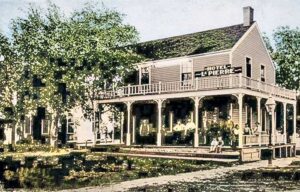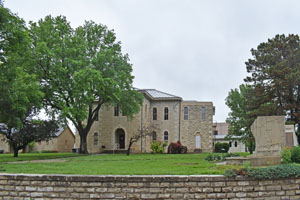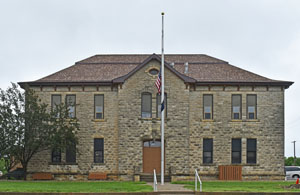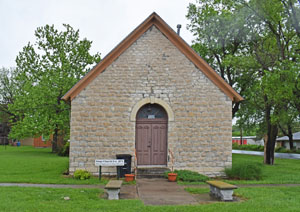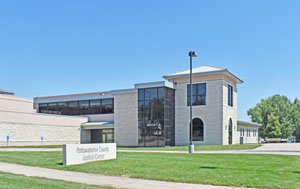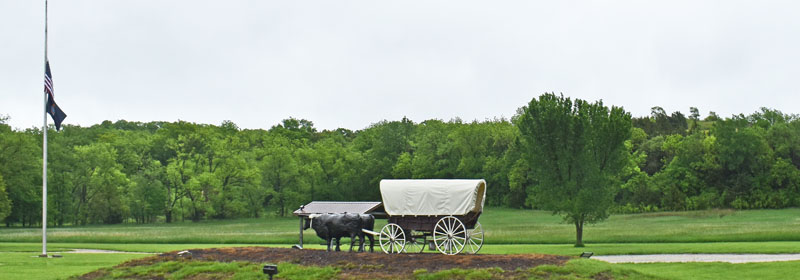Westmoreland, Kansas, located in Rock Creek Township, is the county seat of Pottawatomie County. As of the 2020 census, the city’s population was 740, and its total area was .52 square miles, all of it land.
The Oregon–California Trail crossed Pottawatomie County and passed just south of Westmoreland. Here, travelers were drawn to Scott Spring, which offered a freshwater supply. A campground was established on the east side of Rock Creek, where emigrants often camped before fording Rock Creek below the present bridge. High water was a distinct possibility at Rock Creek, causing travelers a delay for several days. Mineral springs in the area, whose waters possess highly medicinal qualities, also existed. From Rock Creek, the road continued in a northwesterly direction.
“I, like every other pioneer, love to live over again, in memory of those romantic months, and revisit, in fancy, the scenes of the journey.”
— Catherine Haun, California emigration of 1849
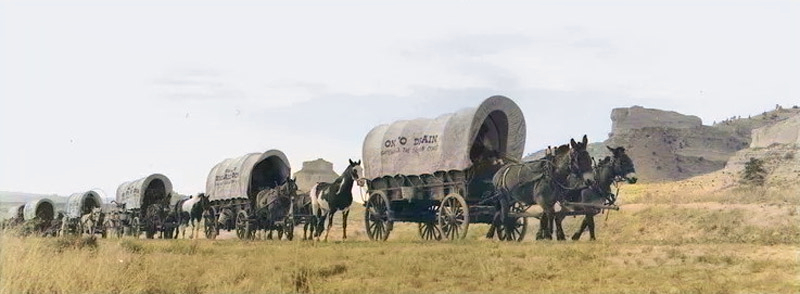
Oregon-California Trail in Northeast Kansas.
The spring and Rock Creek were mentioned in a few diary entries, including Nathaniel J. Wyeth’s second overland expedition to the Far West in 1834 and William L. Sublette’s pack train the same year.
Edwin Bryant’s California-bound party stopped in the Scott Spring vicinity on May 24, 1846, when Bryant noted:
“We found here, gushing from a ledge of limestone rock, a spring of excellent water, from which we refreshed ourselves in draughts that would be astonishing to the most fanatical cold water advocate.”
In 1853, the town of Westmoreland was established.
The first resident, John McKimens, came to the area in 1856.
On June 30, 1858, a post office was established in John McKimens’ home at Rock Creek Crossing. He served as the first postmaster. The post office was named in honor of McKimens’ native county, Westmoreland, Pennsylvania.
Tensions between the Kansas Territory and the State of Missouri escalated in the mid-to-late 1850s, and long-distance trail traffic through Kansas began to slow. Increasingly, emigrants chose to cross the Missouri River farther north and start their westward migration from present-day Nebraska. At this time, traffic along the emigrant trails in Kansas became more localized as settlers moved into the area.
The first house was built as a log structure erected in 1860 at the southeast end of town.
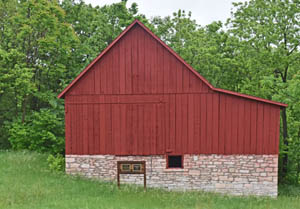
This red barn, built in 1860 by John McKimmons, was placed on the National Register of Historic Places in 2010. It stands just southeast of Westmoreland on Kansas Route 99 near the Rock Creek Bridge.
In 1860, John McKimmons built a barn southeast of Westmoreland. The barn and other contributing structures were placed on the National Register of Historic Places in 2010. It stands on Kansas Highway 99, 1/4 mile south of Westmoreland, near the Rock Creek Bridge.
In the winter of 1862, the first school was established in a log cabin near the corner of what is now State Street and the public highway intersection. Though the school district had no clear boundaries, it served several townships.
By the mid-1860s, the last wagons were fording Rock Creek, and the community became a commercial center.
A.C. and Mary Cochran were the first settlers on the present site of Westmoreland, having moved here from Jackson County in September 1869.
Another early settler to the Westmoreland vicinity was Adam Scott, the spring’s namesake at the Rock Creek Crossing. Scott and his family moved from Scotland to Pottawatomie County in 1870, one year before the town of Westmoreland was established. They settled on the south side of Rock Creek and bought land that once totaled 1,400 acres.
In 1871, Westmoreland was officially platted by Volney Baker, who settled here in 1860.
Cochran built a general merchandise store in town, the first of its kind. An early town builder, he served as postmaster for two terms. Later, he purchased 80 acres of land adjoining the town limits and laid out the Cochran’s first and second additions.
In September 1869, he moved to Westmoreland, where he began business as a merchant. He carried a large stock of general merchandise and was also an extensive farmer.
In 1870, a sawmill on Rock Creek provided lumber for most of the early buildings. It was later sold, and the new owner added machinery to make flour and meal. That same year, a general store opened.
A general store opened in 1871, and Volney Baker recorded the original town plat of Westmoreland on April 15, 1871. Later, J. Rachel Armer and A.C. Cochran made additions.
In 1871, the German Evangelical Association was established in the residence of Wilhelm and Christina Grutzmacher, making it one of the earliest churches in the town.
In 1876, A.C. Cochran built the first stone house in Westmoreland on the corner of State and Fourth Streets.
After several years of heated battles over the location of the county seat, an election was held on September 3, 1879, with Louisville, Wamego, Laclede, and Westmoreland as the candidates. Westmoreland won the runoff with 1877 votes, which surprised many Pottawatomie County citizens.
The first county offices in Westmoreland were established in the Methodist and Congregational Churches and the Detro House Hotel. The county treasurer, county clerk, district clerk, and register of deeds were located in the Methodist Church. Later, a temporary courthouse was erected, which became the Hotel LaPierre. It stood at the corner of Main and 4th Streets.
On October 5, 1882, Jasper K. Whims of Westmoreland and Messrs. Cotton and Anderson issued the first number of the Weekly Period, a five-column, four-page newspaper.
There was much friction over county-seat matters, and a suit was filed in 1882 over the permanent location of the county seat, arising out of an alleged fraudulent canvass of the votes cast. County residents complained about Westmoreland’s mud roads and sidewalks. It became clear to Westmoreland residents that a substantial permanent building was required to retain the county seat. The Westmoreland Citizens Building Association was formed to organize the construction of a permanent courthouse.
In 1883, Westmoreland contained three general stores, four hotels, two churches, one physician, one lawyer, a carpenter shop, a restaurant, a livery stable, and a butcher shop.
On January 14, 1884, two years after winning the county seat, the county commission granted permission to construct a stone courthouse on a block of donated land in the Rachel Armer Addition. The Westmoreland Citizens Building Association rallied, and the citizens of Pottawatomie County donated $10,000 and labor.
The Courthouse Square was designated at the west end of Westmoreland’s downtown business district. The two-story limestone building, measuring 60 by 70 feet, was designed in the Late Victorian style and erected at 106 Main Street. Citizens also donated labor for the courthouse, and the native limestone was hauled to the site by horse and wagon. The first cornerstone was laid on April 24, 1884, by Amos E. Landon, a Freemason from Onaga.
“Westmoreland was straining every nerve to have the new courthouse finished in time to hold the October term of the court within its walls and have the roof on and floors in by the 4th of July.”
— Leavenworth Times, May 2024
Though the inside of the courthouse was not yet completed, it was presented to the county on August 30, 1884. The following month, the County Commission ordered the county offices to move their offices, papers, books, and records into the Courthouse. Westmoreland served as the center of county business with no threat to its status as the county seat for the next 70-plus years.
In 1885, Westmoreland had Methodist, Congregational, Christian, and Baptist Churches and a newspaper called the Weekly Period. It also had two meat markets, two hotels, two general stores, a flour mills, a shoemaker, a barber, two blacksmiths, a lumber dealer, a milliner, two restaurants, a druggist, two wagon makers, a bakery, a livery, a furniture dealer, a hardware store, a sawmill, an attorney, three physicians, several carpenters, two painters, and a population of 350. The nearest bank was at Olesburgh. It had a daily stage line to Wamego and Blaine, which delivered mail to A.M. Baker, the postmaster. The community shipped livestock, grain, and produce.
In 1887, a stone building was built for the German Evangelical Church at the northeast corner of 6th and State Streets.
In 1890, Leonora Van Brunt was the proprietor of a large dry goods and general mercantile store in Westmoreland. She was a stockholder in the First National Bank of Westmoreland and owned property on Main and State Streets. She was described as a pioneer and foremost resident of Pottawatomie County, eventually prospering on a 160-acre farm. After separating from her husband Jacob in 1872, she moved to Westmoreland and received her commission as postmistress, serving six years in the post. She opened a general mercantile in 1874 and built a flourishing trade for many years.
The Westmoreland Elementary School was constructed in 1898. This two-story stone t-shaped building was designed in the Vernacular style with a hip roof, a gable dormer over the front entry, and a bracketed wood cornice.
After several attempts, bonds were passed to establish the Kansas and Southern Railroad in the area that year. Just four years later, in 1902, the railroad went bankrupt.
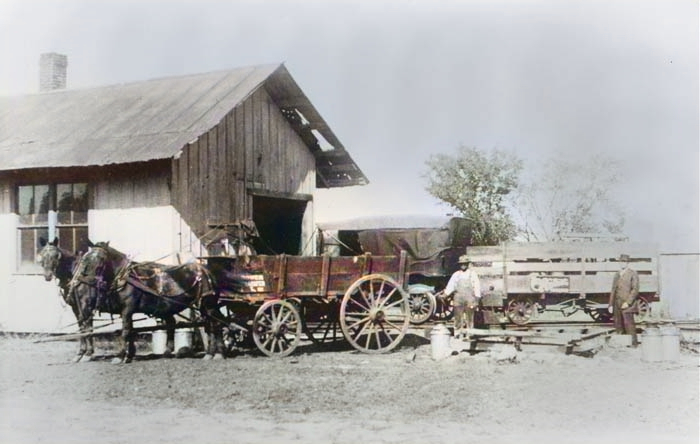
Depot in Westmoreland, Kansas.
In 1910, Westmoreland was on the Kansas Southern & Gulf Railroad, which connected with the Union Pacific Railroad at Blaine, eight miles north. At that time, it had one national bank, two state banks, an opera house, two newspapers, and all the general lines of business activity. On the south line of the county, there were daily stage lines to Louisville and Wamego. Its population was 500.
As many as 40 men labored through the winter months and early spring of 1914 on Westmoreland’s city water well. At the time, there was no modern machinery to aid their efforts. These men used picks and shovels to dig the well. After nearly three-quarters of a century of neglect, the well and about one acre of land surrounding it were transferred to the Rock Valley Historical Society and were restored. It is the second largest hand-dug well in the state of Kansas. It is located at 401 N. 99 Highway, south of City Park and RV Park.
The original pump house, built in 1910 for the well, was dismantled, with each stone numbered and moved by horse and wooden wagon to the corner of Main and 2nd Street. It was reassembled and now serves as the city hall for Westmoreland.
In 1910, a one-story limestone jail was built west of the courthouse. The building, measuring 20 by 32 feet, had two six-foot-by-seven-foot cells and a corridor.
1912 The Westmoreland Interurban Railway began.
In 1914, the Church of Christ purchased the German Evangelical Church property.
1915 The owner of the Westmoreland Interurban Railway died tragically, and the railway was sold for scrap iron.
On March 15, 1942, Dr. Thomas Dechairo opened the first hospital in Westmoreland.
Reports of falling plaster and peeling paint brought the Courthouse building back to the forefront of the county. In the mid-1960s, an editorial in the Wamego newspaper suggested that a new courthouse was needed and that consideration should be given to building one in Wamego. This endeavor was the first known attempt to demolish the existing Courthouse. After a prolonged battle that included a court case, the Board of Commissioners ultimately spent money on repairs to the existing Courthouse.
The old jail served the County until about 1970 when a new jail was constructed northwest of the courthouse. Afterward, the old jail was used for storage, but the building is now boarded and unused. The jail is a contributing building on the courthouse site.
In 1977, the old German Evangelical Church building became the site of the Rock Creek Valley Historical Society Museum. It was listed on the National Register of Historic Places in January 2018. It is located at 100 South 6th Street.
Westmoreland High School was closed through school unification in 1991.
The Westmoreland Grade School was closed in 1992 when the elementary was moved to the former high school. Afterward, the county bought this building and converted it to a courthouse annex. It is located at 207 N. 1st Street. That year, the Dechairo Hospital merged with Stormont Vail in Topeka, Kansas.
The city’s population peaked in 2010 at 778.
The historic limestone courthouse continued to serve court functions until a new Justice Center was built directly behind it in 2013. On the grounds of the original courthouse, located at the corner of Main and 2nd Street, is a memorial to those who served in the armed services from Pottawatomie County. The building is the second oldest courthouse built out of native limestone in the state. It was listed on the National Register of Historic Places in January 2018.
Today, Rock Creek’s USD 323 public school district serves the community. The district was unified by consolidating St. George and Westmoreland schools. Rock Creek High School is located approximately halfway between the two communities, and Westmoreland Elementary School is in Westmoreland.
On April 30, 2024, an EF3 tornado struck Westmoreland, causing one death and three injuries, destroying 22 homes, and damaging 13 homes that are still livable.
South of town, on Highway 99, is the Oregon Trail Park, dedicated to travelers on the Oregon Trail. It has informational signage, an old pioneer grave site, a covered wagon, and oxen sculptured by Ernest White, a local resident. Since this area along the trail was frequently used, ruts from the early wagon trains can still be seen.
“In the early days of this nation, before railroads and highways were constructed, people traveled on foot, on horseback, by boat, or by wagon. Some of these trails remain in existence today as reminders of this diverse historic past. Stories of the Oregon Trail…and others bring to mind exciting and sometimes tragic chapters
— National Trails System Map and Guide
The town’s largest employers are the County Court System and Jail, the Westmoreland Community Care Home and Assisted Living Facilities, and Unified School Districts.
Being a comparatively new town, Westmoreland is one of the smallest county-seat towns in the eastern part of the state.
Westmoreland is located 13 miles north of Wamego on Highway 99.
©Kathy Alexander/Legends of Kansas, updated November 2024.
Also See:
Extinct Towns in Pottawatomie County
Pottawatomie County Photo Gallery
Sources:
Blackmar, Frank W.; Kansas: A Cyclopedia of State History, Vol I; Standard Publishing Company, Chicago, IL 1912
Cutler, William G; History of Kansas; A. T. Andreas, Chicago, IL, 1883.
City of Westmoreland
Historial Marker Database
Kansas Historic Resource Inventory
National Park Service
National Register Nomination – County Courthouse
National Register Nomination – Scott Spring
Polk’s 1884-1885 Official State Gazetteer and Business Directory of Kansas; R.L. Polk & Co., Detroit, MI.
Wikipedia
Zabel, Michael J.; Go West More Land — The Early Years of Westmoreland, Kansas. Self-published in Westmoreland, Kansas, 2005.


